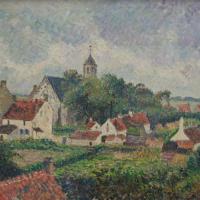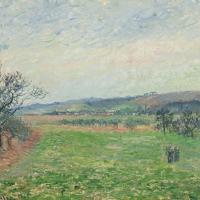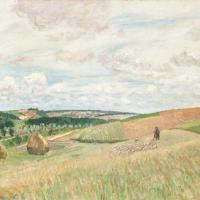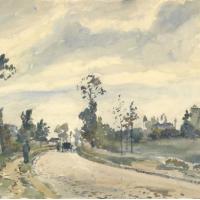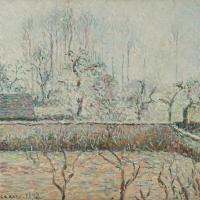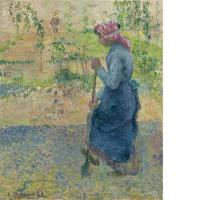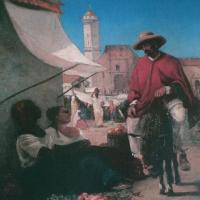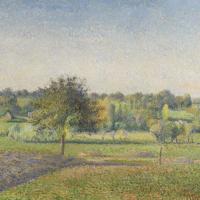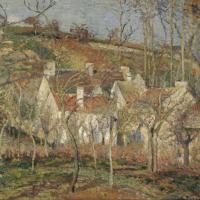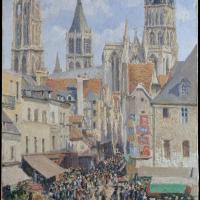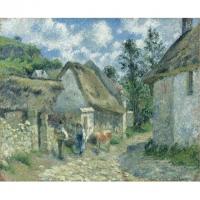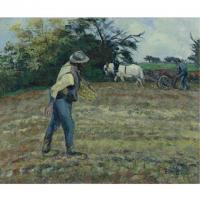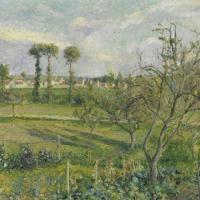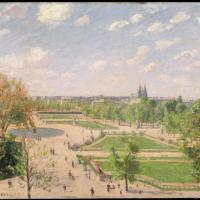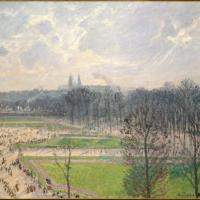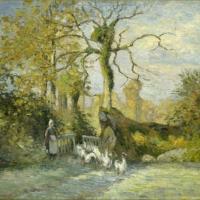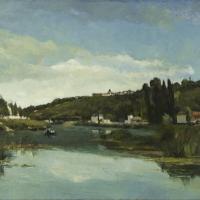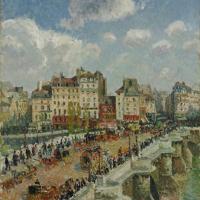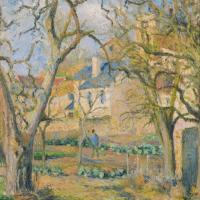Camille Pissarro
Le Verger (The Orchard)
$450.00
Le Village De Knocke
$450.00
Les Coteaux De Gisors
$450.00
Les Coteaux De Thierceville
$450.00
Louveciennes
$450.00
Orchard With Flowering Trees
$450.00
Paysanne Couchant
$450.00
Plaza Mayor, Caracas
$450.00
Prairie Ragny
$450.00
The Louvre
$450.00
The Louvre Under Snow
$450.00
The Marne At Chennevieres
$450.00
The Pont Neuf
$450.00
Vegetable Garden
$450.00
Camille Pissarro
Camille Pissarro (1830-1903)
Camille Pissarro (10 July 1830 – 13 November 1903) was a Danish-French Impressionist and Neo-Impressionist painter born on the island of St Thomas (now in the US Virgin Islands, but then in the Danish West Indies). His importance resides in his contributions to both Impressionism and Post-Impressionism. Pissarro studied from great forerunners, including Gustave Courbet and Jean-Baptiste-Camille Corot. He later studied and worked alongside Georges Seurat and Paul Signac when he took on the Neo-Impressionist style at the age of 54.
In 1873 he helped establish a collective society of fifteen aspiring artists, becoming the "pivotal" figure in holding the group together and encouraging the other members. Art historian John Rewald called Pissarro the "dean of the Impressionist painters", not only because he was the oldest of the group, but also "by virtue of his wisdom and his balanced, kind, and warmhearted personality". Paul Cézanne said "he was a father for me. A man to consult and a little like the good Lord," and he was also one of Paul Gauguin's masters. Pierre-Auguste Renoir referred to his work as "revolutionary", through his artistic portrayals of the "common man", as Pissarro insisted on painting individuals in natural settings without "artifice or grandeur".
Pissarro is the only artist to have shown his work at all eight Paris Impressionist exhibitions, from 1874 to 1886. He "acted as a father figure not only to the Impressionists" but to all four of the major Post-Impressionists, Georges Seurat, Paul Cézanne, Vincent van Gogh, and Paul Gauguin.
Jacob Abraham Camille Pissarro was born on 10 July 1830 on the island of St. Thomas to Frederick and Rachel Manzano de Pissarro. His father was of Portuguese Jewish descent and held French nationality. His mother was from a French-Jewish family from the island of St. Thomas. His father was a merchant who came to the island from France to deal with the hardware store of a deceased uncle, Isaac Petit, and married his widow. The marriage caused a stir within St. Thomas' small Jewish community because she was previously married to Frederick's uncle and according to Jewish law a man is forbidden from marrying his aunt. In subsequent years his four children attended the all-black primary school. Upon his death, his will specified that his estate be split equally between the synagogue and St. Thomas' Protestant church.
When Camille was twelve his father sent him to boarding school in France. He studied at the Savary Academy in Passy near Paris. While a young student, he developed an early appreciation of the French art masters. Monsieur Savary himself gave him a strong grounding in drawing and painting and suggested he draw from nature when he returned to St. Thomas, which he did when he was seventeen. However, his father preferred he work in his business, giving him a job working as a cargo clerk. He took every opportunity during those next five years at the job to practise drawing during breaks and after work.
When Pissarro turned twenty-one, Danish artist Fritz Melbye, then living on St. Thomas, inspired him to take on painting as a full-time profession, becoming his teacher and friend. Pissarro then chose to leave his family and job and live in Venezuela, where he and Melbye spent the next two years working as artists in Caracas and La Guaira. He drew everything he could, including landscapes, village scenes, and numerous sketches, enough to fill up multiple sketchbooks. In 1855 he moved back to Paris where he began working as assistant to Anton Melbye, Fritz Melbye's brother.
In his older age Pissarro suffered from a recurring eye infection that prevented him from working outdoors except in warm weather. As a result of this disability, he began painting outdoor scenes while sitting by the window of hotel rooms. He often chose hotel rooms on upper levels to get a broader view. He moved around northern France and painted from hotels in Rouen, Paris, Le Havre and Dieppe. On his visits to London, he would do the same.
Pissarro died in Paris on 13 November 1903 and was buried in Père Lachaise Cemetery.
During the period Pissarro exhibited his works, art critic Armand Silvestre had called Pissarro the "most real and most naive member" of the Impressionist group. His work has also been described by art historian Diane Kelder as expressing "the same quiet dignity, sincerity, and durability that distinguished his person." She adds that "no member of the group did more to mediate the internecine disputes that threatened at times to break it apart, and no one was a more diligent proselytizer of the new painting."
According to Pissarro's son, Lucien, his father painted regularly with Cézanne beginning in 1872. He recalls that Cézanne walked a few miles to join Pissarro at various settings in Pontoise. While they shared ideas during their work, the younger Cézanne wanted to study the countryside through Pissarro's eyes, as he admired Pissarro's landscapes from the 1860s. Cézanne, although only nine years younger than Pissarro, said that "he was a father for me. A man to consult and a little like the good Lord."
Lucien Pissarro was taught painting by his father, and described him as a "splendid teacher, never imposing his personality on his pupil." Gauguin, who also studied under him, referred to Pissarro "as a force with which future artists would have to reckon". Art historian Diane Kelder notes that it was Pissarro who introduced Gauguin, who was then a young stockbroker studying to become an artist, to Degas and Cézanne. Gauguin, near the end of his career, wrote a letter to a friend in 1902, shortly before Pissarro's death:
"If we observe the totality of Pissarro's work, we find there, despite fluctuations, not only an extreme artistic will, never belied, but also an essentially intuitive, purebred art ... He was one of my masters and I do not deny him."
The American impressionist Mary Cassatt, who at one point lived in Paris to study art, and joined his Impressionist group, noted that he was "such a teacher that he could have taught the stones to draw correctly."
Caribbean author and scholar Derek Walcott based his book-length poem, Tiepolo's Hound (2000), on Pissarro's life.



